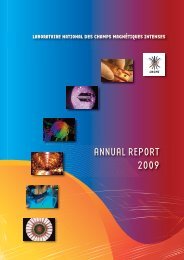Laboratoire National des Champs Magnétiques Pulsés CNRS – INSA
Laboratoire National des Champs Magnétiques Pulsés CNRS – INSA
Laboratoire National des Champs Magnétiques Pulsés CNRS – INSA
You also want an ePaper? Increase the reach of your titles
YUMPU automatically turns print PDFs into web optimized ePapers that Google loves.
In recent years, several scientific projects at the LCMI have been funded by the ANR. Unfortunately, the<br />
ANR refuses to fund project related to the high field installation. An ANR program to fund mid-scale<br />
investments at the French TGE is sadly lacking.<br />
Summary of the technical activities at the LCMI<br />
Presently the LCMI is equipped with an electrical power and cooling installation of 24 MW. It has eight<br />
magnet sites: five produce fields up to 23 T with 12 MW, three consume 24 MW and reach fields of<br />
respectively 35 T, 28 T and 18 T in bore diameters of 34 mm, 50 mm and 160 mm.<br />
Over the last few years, a steady increase in maximum field strength has been realized by improving magnet<br />
<strong>des</strong>ign, materials developments and new cooling techniques. Thanks to these activities, the LCMI currently<br />
shares the world record resistive magnetic field with the NHMFL, in spite of a much lower budget.<br />
The laboratory is currently heavily investing in the realization of a hybrid magnet producing 42 T in a 34 mm<br />
diameter. This project replaces an earlier project, in which the superconducting outsert, fabricated by an<br />
industrial partner, was defective and beyond repair. No alternative industrial supplier could be found ant the<br />
laboratory is now obliged to coordinate the manufacturing of the superconducting cable and the construction<br />
of the magnet and its cryogenics.<br />
During the last years, a large effort has been made to improve the stability of the power supply, now reaching<br />
values of 5.10 -6 . This result mainly benefits the development of high resolution NMR at the LCMI.<br />
A part from its in-house installation, the LCMI has been strongly involved in the development of other high<br />
magnetic field installations, in collaboration with other institutions. It has strongly contributed to the FP7<br />
Design Study ‘ESRFUp’ in which, amongst others, the possibility of the construction of a new high field<br />
installation (40 MW, 30+ T) between the sites of the ESRF and the ILL is investigated. The results of this<br />
study confirm the technical feasibility of such an installation and the magnets necessary to perform neutron<br />
and X ray scattering experiments in fields above 30 T. In collaboration with the LPSC and using the unique<br />
LCMI magnet technology, a special magnet was <strong>des</strong>igned that will constitute the heart of the new European<br />
electron cyclotron resonance ion source.<br />
More details on these technical activities can be found below, or in greater detail in the annual reports<br />
(http://ghmfl.grenoble.cnrs.fr)<br />
Summary of the scientific activities at the LCMI<br />
The scientific activities of the LCMI are spread out over many topics in condensed matter science. A more<br />
detailed overview will be presented later on. They are all related to the effects of a large magnetic field on<br />
the physical properties of materials or nanostructures, the other parameters being varied being typically<br />
temperature or pressure. The scientific production of the laboratory over the reporting period is 440<br />
publications (ACL, ACT), of which 48 with an impact factor over 6 (Phys. Rev. Lett., JACS, etc) and 4 with<br />
an impact factor over 15 (Science, Nature etc). In view of the small number of scientists (10 permanent<br />
scientists in 2009), this is an extraordinary result, proving the large added value of high magnetic fields as a<br />
research tool and the high quality of the LCMI installation and researchers.<br />
Several specific experiments have been developed to explore various new properties in high magnetic fields<br />
that are unique in the world. In the following paragraphs a few highlights will be given.<br />
In semiconductor physics, including its modern "nano" and "spintronics" branches, magnetic fields are used<br />
as a powerful tool to study material properties or to create unique systems, unavailable by other means.<br />
Focusing on the effects of electron-electron interaction, the appearance of Stoner transition which drives<br />
2DEG into a ferromagnetic state has been demonstrated with transport experiments. Electron-electron<br />
interactions have been also shown to be apparent in cyclotron resonance absorption of a 2DEG and to play<br />
an important role in determining the spin and charge state of optically probed single quantum dots and to<br />
affect the electronic transport of a 2DEG via plasmon excitations. The studies of anisotropic transport<br />
(ratchet effect) induced by microwave excitations in a 2DEG with an intentional anisotropic disorder, and of<br />
other microwave induced effects have revealed interesting mesoscopic phenomena which may be also<br />
important for applications.<br />
The newly discovered graphene, essentially a carbon monolayer, has been a very fertile playground for the<br />
LCMI scientists; Raman scattering studies of multilayered graphene have confirmed its unique Dirac-like<br />
electronic like spectrum, previously uncovered with magneto-spectroscopy methods. The appearance of<br />
3







